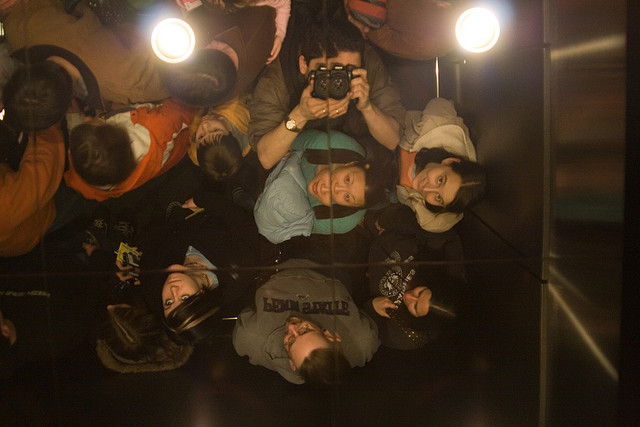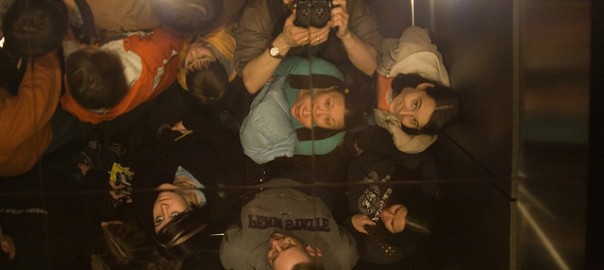
A month or so ago I had a disagreement with my sister-in-law. I’d read about how many traffic crossing buttons and elevator buttons to close the doors were not wired up to anything. She claimed I was wrong and I couldn’t remember where I’d read it. Luckily, I recently came across an article on Placebo Buttons at Your Are Not So Smart.
According to a 2008 article in the New Yorker, close buttons don’t close the elevator doors in many elevators built in the United States since the 1990s.
Now, the crux of her argument was that it actually worked in her dorm. And dorms tend to be the last places on campus upgraded to new facilities (if Cornell is any indication), so perhaps it was put into place earlier than 1990.
The website, The Straight Dope, investigated the issue in 1986 by asking elevator companies and elevator repairmen directly. According to their investigation, “The grim truth is that a significant percentage of the close-door buttons in this world…don’t do anything at all.” The reasons cited were that the button was never wired up, or that it was set to a delay, or was deactivated by the owner, or it broke long ago and no one ever complained because the doors eventually close whether or not you press the buttons.
If you happen to find yourself pressing a non-functional close-door button, and later the doors close, you’ll probably never notice because a little spurt of happiness will cascade through your brain once you see what you believe is a response to your action. Your behavior was just reinforced. You will keep pressing the button in the future.
Key to this is that I have NEVER seen a door close button that immediately closes an elevator. It often appears to close it faster, but by such a smaller amount than if it hadn’t been pressed, that I’ve often wondered if I wasn’t imagining the difference. And this article shows that I was right – it probably didn’t do anything. What I have seen them appear to do it keep the doors from opening again if someone presses the button outside to call an elevator just before yours has left. However, my reason for writing the article is less as a public “I told you so” and more of an explanation of how our brains see cause and effect where there is none. This can be exploited with placebo buttons to get people to do what you want. For example, the author mentions that many of the air conditioning thermostats in public buildings don’t actually do anything:
“We had an employee that always complained of being hot,” recalls Greg Perakes, an HVACR instructor in Tennessee. “Our solution was to install a pneumatic thermostat. We ran the main air line to it inside of an enclosed I-beam. Then we just attached a short piece of tubing to the branch outlet (terminating inside the I-beam without being attached to any valves, etc.).”
The worker “could adjust her own temperature whenever she felt the need,” Perakes says, “thus enabling her to work more and complain less. When she heard the hissing air coming from inside the I-beam, she felt in control. We never heard another word about the situation from her again. Case solved.”
So the worker can’t possibly be any cooler than before she set the thermostat, but when she lowered the temperature it appeared to be working so even if she still felt hot, it was the building’s crappy A/C – not because she wasn’t being allowed to adjust the thermostat. Think about that the next time you push a button and get a result – the connection might not be what you think it is.


2 responses to “Placebo Buttons”
I always think placebo effects are interesting.
I usually hit the door close button in elevators even though I know they don’t do anything. I think it’s just because I have nothing better to do in the elevator.
I also hit traffic crossing buttons. These I know don’t change the light faster, but I thought they sometimes control whether or not the walk sign actually tells you to walk.
Yeah, I hate when it’s rigged to not show the “walk” sign if you don’t push the button. Generally speaking, you walk when the parallel traffic has the green light so it’s annoying they don’t just automatically illuminate the “walk” sign. Usually, I just keep an eye on the traffic lights.
Of course, there are a handful of places where the button does control the light – such as areas where you don’t expect pedestrians very often. When we were little kids there was a light on our block that was controlled by the crosswalk because the only time anyone would need to cross would be to go to the church across the street. We used to get in a lot of trouble with out parents for turning the light red. Unbeknownst to our young brains, we almost caused an accident because that light was always green so one time when we turned it red a car slammed on its brakes and was almost hit by the car behind it.